Why Volos is Perfect in Autumn
The charming port city of Volos...

Riverside at Aristi-Papingo Bridge
© Olga Charami
The locals at Kipoi, Tymfi and Vikos say that the water of the Voidomatis River is clean enough to drink, and will happily do so themselves to demonstrate. Here, you’re close enough to the source of the river to make it unlikely that any impurities could have entered the stream. It’s certainly worth a swim in the frigid water. The easiest beach to reach – and therefore the most popular – is at the Papingo Bridge, right by the road. The plane forest and the cold, deep, blue-green waters create a fairytale landscape. Just a little to the west of the bridge, you’ll see a sign for an amazing trail, which winds alongside the river and leads to the Klidonia Bridge. The hike itself shouldn’t take more than two and a half hours, but along the way you’ll find small beaches for swimming that could stretch it out into a full day. Just remember that, as this is a National Forest, you shouldn’t use sunscreen (it taints the water), cut any flowers or herbs, or leave any rubbish behind.
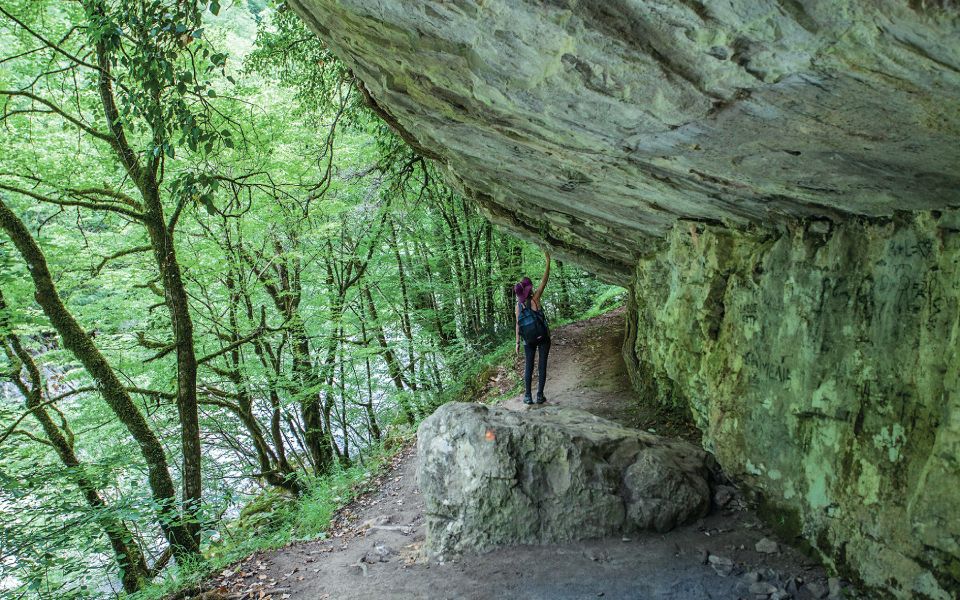
Vikos Gorge
© Olga Charami
For years, I looked forward to the moment when I would traverse the Vikos Gorge, one of the most notable gorges in the world, its fame resting on the proportions it presents. The Guinness Book of World Records lists it as the world’s deepest gorge in relation to its width; it’s 1100m wide and 900m deep. I had looked down into it from a number of viewpoints, including those of Oxia and Spitalia near the village of Monodendri and Beloe in Vradeto. Every time, the stunning spectacle made me want to explore this miracle at the heart of the Vikos-Aoos National Park, which is also a UNESCO Geopark. When you do trek the gorge, however, it loses just a bit of its mystique, as you find yourself walking for five to seven hours through the same – albeit beautiful – landscape. The only sounds are from birds and insects, although you may find yourself listening hard to make sure there are no bears around. The gorge is known for its wild herbs. At times, you’ll be walking under stone outcroppings. Summer is the ideal season, as the Voidomatis River is very low, except at its source. The classic route through the gorge starts either at Monodendri and ends at the village of Vikos or vice-versa, but there are other options. In any case, you’ll want to be following the signs for the O3 Trail. Be sure to give yourself ample time, as the distances you need to cover are significant.
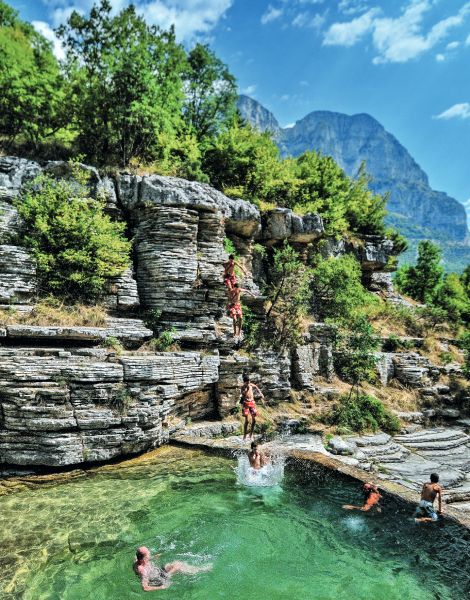
Ovires
© Olga Charami
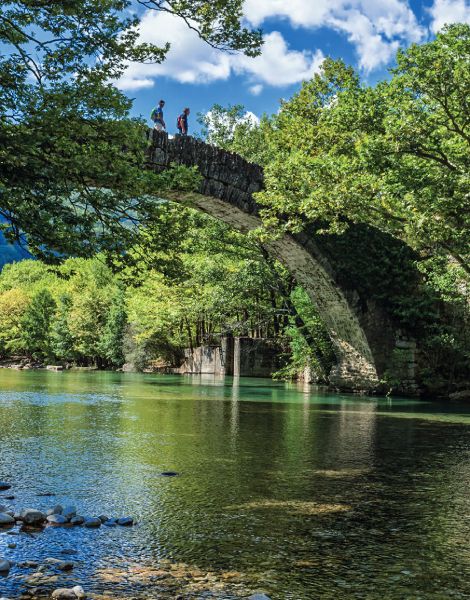
Klidonia Bridge
© Olga Charami
Imagine large natural troughs carved by the currents of the Rogovos River flowing down from Tymfi, blue-green waters where you can swim, and smooth rocks where you can lie back and take in the small waterfalls and rich vegetation. This is Ovires, or Kolymbithres, located between Mikro and Megalo Papingo, in the Rogovos Gorge. The flow of water between these natural reservoirs, which act like connected holding tanks, is controlled with a series of sluices and dams that locals use to create luxurious natural swimming pools.
Around 100 stone bridges adorn the rivers and creeks of Zagori, blending seamlessly into the natural world surrounding them. They were built in the 18th and 19th century by renowned craftsmen who tried to tame the rough landscape of high mountains and deep gorges by easing the movement of people and goods from place to place. Rounded or pointed, with single or multiple arches, all are works of art. It is worth spending some time admiring the stonework, now often overgrown with weeds, and noting the clever architecture that went into these structures. Some of them can be easily spotted from the road, including the bridge of Noutsos (also known as Kokkori or Kokkorou) on the road from Dilofo to Koukouli. Others require a short walk, such as Plakida or Kontodimou with its triple arch on the edge of the village of Kipoi. For still others, you’ll need to take longer hikes. Some of the easier treks include the circular path around Kipoi, which takes in four bridges, and the one starting at Vitsa and ending at the Kokkori Bridge, which takes about an hour and a half – it’s very manageable, suitable for children, and takes in the Skala (stone steps) at Vitsa and the Bridge of Misiou as well.

Sterna
© Olga Charami
Sterna is a one-of-a-kind shop, and its owner, Elli Papageorgiou, is one of a kind, too. She was raised in Kapesovo. Her father was a champion of self-sufficiency, and she found herself like a real-life Little Red Riding Hood foraging for berries and herbs in the forest, and learning about them at her mother’s side. Today she runs Sterna in Megalo Papingo, a quirky café with a beautiful terrace, where you can enjoy homemade beverages and sweets – in summer this means homemade lemonade or sour cherry cordial, cake with chocolate sauce and ice cream, halva mousse and “Little Red Riding Hood” ice cream. Afterwards, you can browse the shelves for anything from fruit preserves and liqueurs, handmade by Elli, to powdered mushrooms and other local products. You can also pick up gifts, decorative items and fashion accessories, many of which are also made by the owner (Tel. (+30) 697.720.2817).

Balta di Striga
© Olga Charami

Rafting in Voidomatis River
© Olga Charami
I had barely reached the Balta di Striga waterfalls at Iliochori, the northernmost village in central Zagori, but I could hear the splashes, over and over again, as three friends from Thessaloniki dove into the green waters. The Vlach name translates as “Lake of the Scream; it is said that a young woman once jumped to her death here. Three mountain pools are formed by an equal number of waterfalls, the largest of which is around 20 meters high. The trail from the village is paved and takes about 30 minutes to walk, while the space next to the largest of the pools has a wooden platform with picnic tables. There are also life buoys for safety. The steep uphill return can be a bit tiring, but the sense of wellbeing after a rejuvenating swim makes it well worth the effort.
Those who go rafting on the Voidomatis in the summer usually leave the rafts with smiles and words of praise. Water levels may be low this time of year, but that’s probably part of what makes the activity a favorite for families. Parents with children can also choose among easy hikes and rides on electric bikes in the virgin forest of the Gyftokampos area. For others, there is canyoning in the Rogovos Gorge (one easy route and one very challenging option), and mountain biking on forest trails of varying degrees of difficulty. River trekking in Vikaki (if there is water) or at the source of the Voidomatis, where there is water year-round, offers a unique way to see this beautiful section of the Vikos Gorge which is not traversed by the Vikos trail. All of these activities can be undertaken safely with the specialists at Trekking Hellas in Ioannina (Tel. (+30) 694.475.0009).
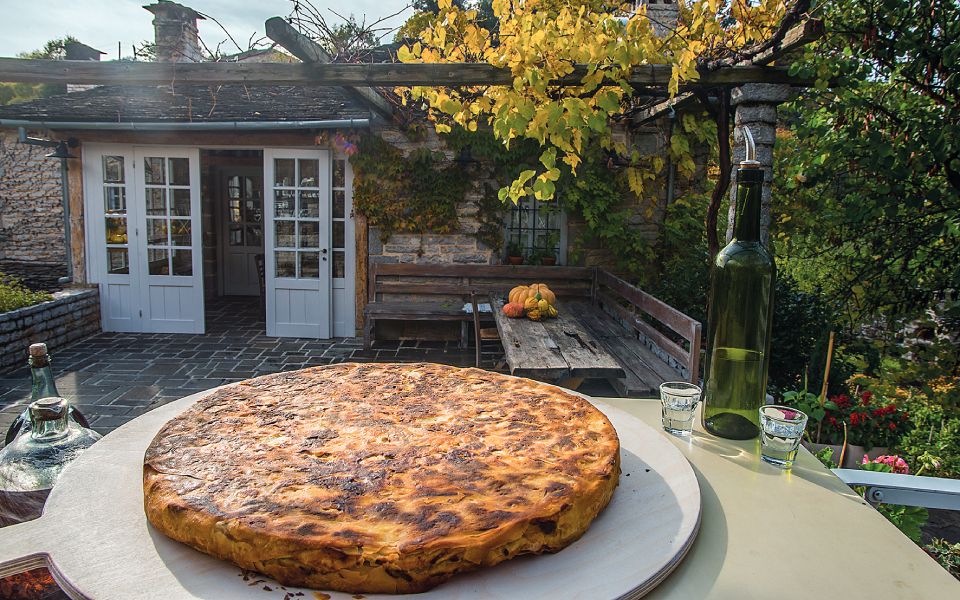
© Olga Charami
I can’t imagine a more spectacular setting for enjoying the sunset than a terrace with a view of the imposing natural towers of Astraka, rising dramatically over Mikro and Megalo Papingo, and it’s even better when the view is accompanied by a delicious dinner. At Astro (Tel. (+30) 26530.421.08) in Megalo Papingo, one of the best tavernas in Epirus, the Tsoukmanis brothers serve as their own suppliers; they raise their own animals, grow their own vegetables and everything they serve is thoroughly homemade. They have superb lamb chops; tender kid goat; fresh salads; savory pies; risotto with wild mushrooms; zucchini flowers stuffed with rice; and the local specialty skotobriamo (liver with rice and seasonings baked in the oven). An old standard, popular with climbers, is Dias (Tel. (+30) 26530.412.57) in Mikro Papingo, featuring an alternating menu of classic comfort food, including well-seasoned beef patties, lamb chops, and unforgettable savory pies. You’ll also find good grilled meat dishes served with a view at the Pantheon (Tel. (+30) 26530.422.39), and Nikos & Julia (Tel. (+30) 26530.418.93).
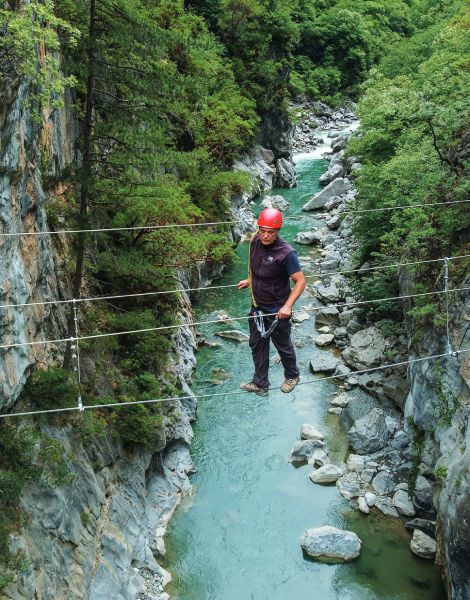
The via Ferrata of Aoos River
© Olga Charami
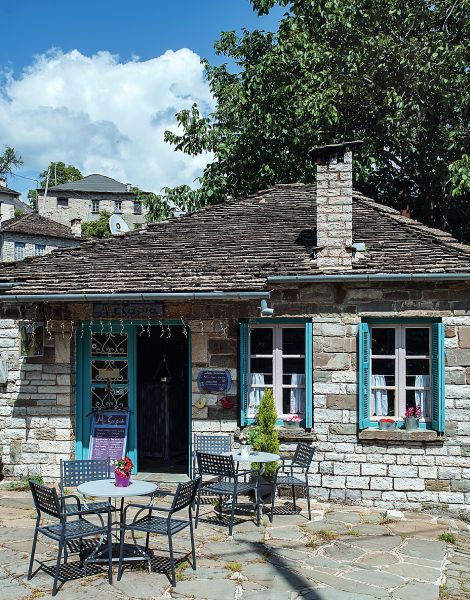
café Mezaria
© Olga Charami
Nikos Kyritsis refers to the Aoos River as his “dad”, and it’s hardly an exaggeration, as he has lived his entire life alongside the waters of the roaring river, and has learned many lessons from it. You’ll find him in Konitsa, which may not be officially part of Zagori but is just 20km from Aristi. He can take you monorafting and river trekking on the Aoos, send you across ziplines, and show you the amazing via ferrata (a climbing route with steel cables, rungs or ladders affixed to the rock) here, which is the longest and most impressive in Greece. The course is very manageable at the start, with a few metal steps and a small rope bridge, and the climbing sections are relatively easy. Everything changes when you reach the 15m-long bridge which spans the river at a height of 35 meters. Crossing that wire bridge while looking down into the captivating Aoos Gorge is an incomparable experience sure to cause an adrenaline rush. Estimate around 4 hours for the course; all the equipment is provided by Nikos and the trip also includes a free stay at a mountain refuge (No Limits, Tel. (+30) 694.475.1418). While you are here you can visit the Stomiou Monastery (accessible from the via ferrata) and the stone bridge in Konitsa, and dine at the restaurant Gefyri (Tel. (+30) 26550.237.80) in the most picturesque location in the area.
The gentle mountain breeze stirs the leaves of the old plane tree until you swear you can hear it whispering. There’s no other sound – Kapesovo is one of the quietest and most beautiful of the stone villages of Zagori. The old village café Mezaria is operating again, revived by the young photographer Konstantinos Vasilakis who settled here seven years ago. Coffee, sweets, savory pies and snacks, as well as interesting conversations about his photographic expeditions will keep you in the old square for hours. You might also enjoy the atmosphere at the traditional coffeehouse in Bradeto, especially if you’ve just ascended the famous Skala, the cobblestone mule track which, until as recently as 1970 when the road was built, was the only link to the village of Kapesovo. If you’re in the mood, take the 20-minute walk from here to Beloe, to enjoy perhaps the most beautiful view of the Vikos Gorge. Alternatively, it’s equally pleasant just to sit in the local café and try local delicacies washed down with tsipouro to the traditional tunes from the cassette player. The café Vikogiatros in Koukouli is of particular interest for its herbal remedies. Owner Nikos Kontodimos can tell you all about their therapeutic properties and offer you one of his unique herbal teas. At the café Mesohori, you’ll find yet more tsipouro, tasty dishes and good company.
The charming port city of Volos...
From the salt-sprayed islands to the...
The imposing mountain range of Agrafa...
When the summer crowds depart, Greece’s...